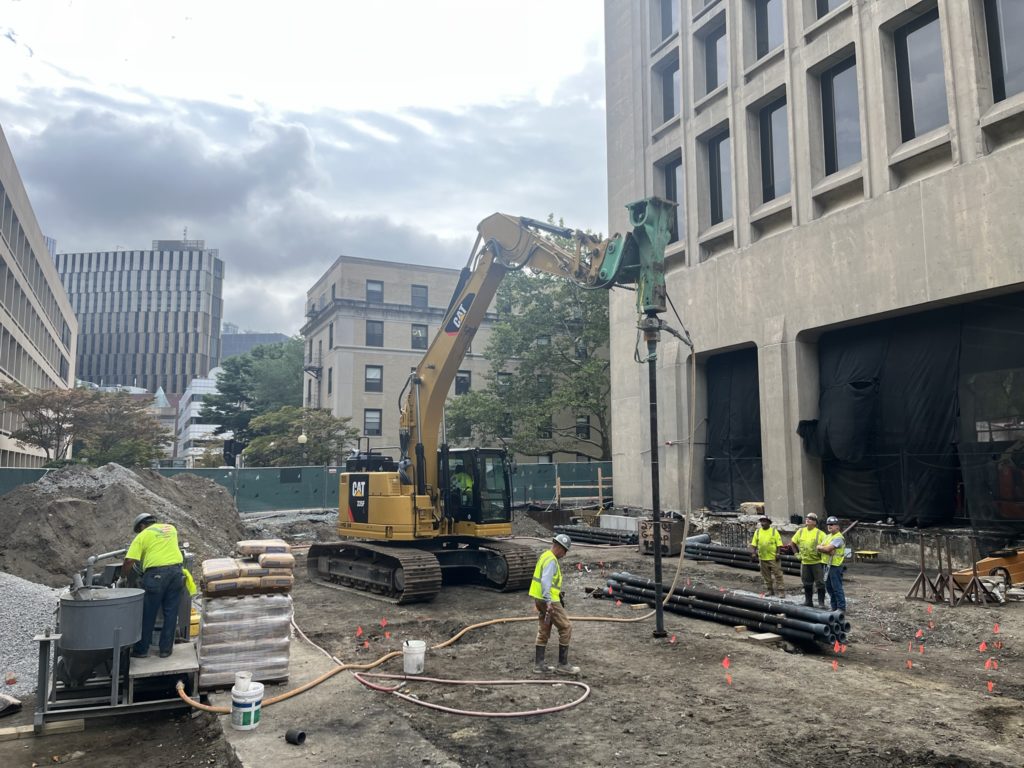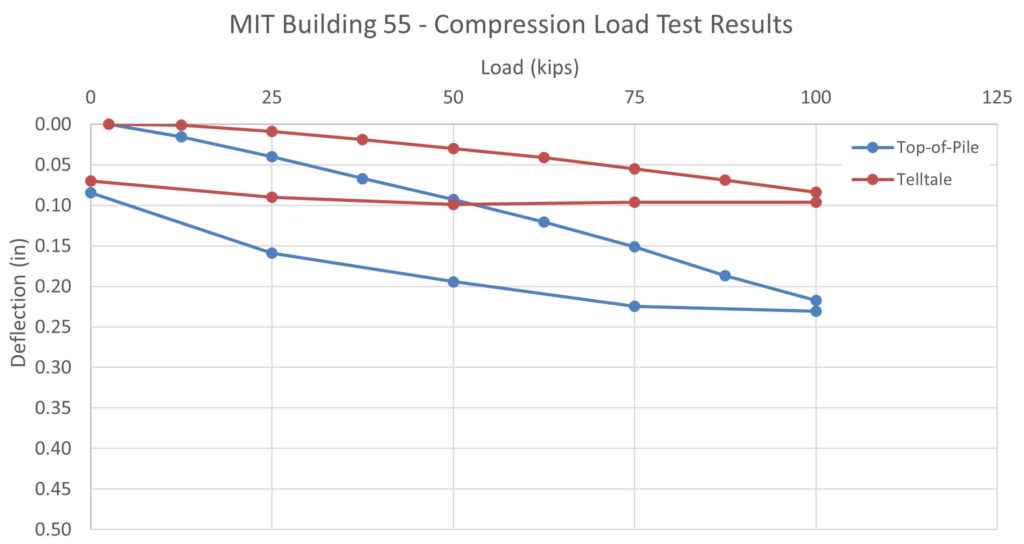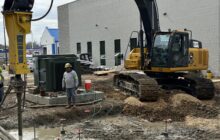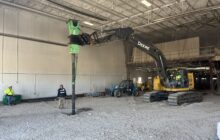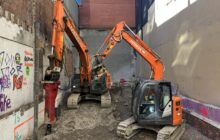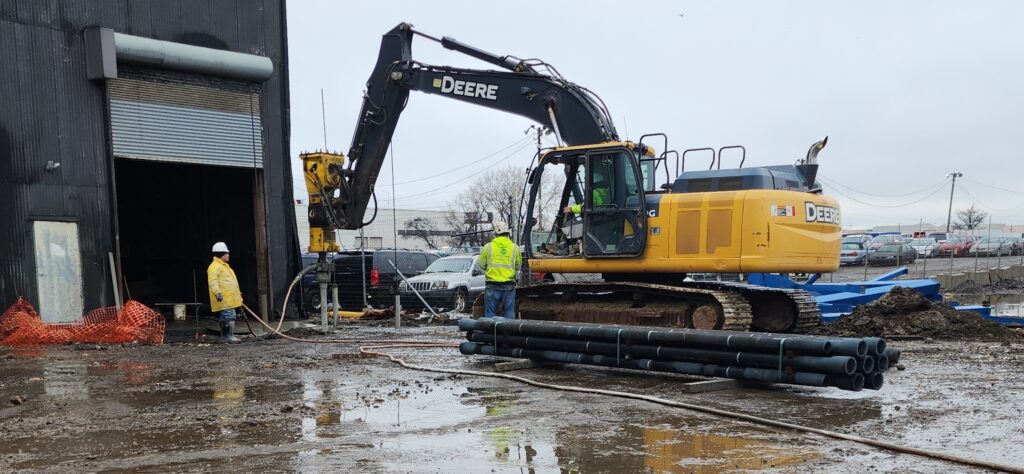Ductile Iron Piles provided a low vibration deep foundation solution to support the new foundations while working on the constrained site and protecting the existing buildings and tunnel from installation impacts.
Project Description:
Renovation work of the existing Cecil and Ida Green Building (Building 54) on the M.I.T. campus involved the construction of a new gateway Pavilion (Building 55) to serve as the entrance to the renovated home of the Earth, Environmental and Climate Sciences Research and Education building. Construction of the single-story pavilion required support of new foundations with loads up to 400 kips. The foundation design and construction also needed to work around an existing service tunnel that crossed the site.
Geotechnical Conditions:
Soil conditions consisted of about 7 to 12 feet of uncontrolled fill underlain by 6 to 14 feet of very loose sand and silt with organics followed by medium dense to very dense sand extending another 7 to 10 feet. The sand was underlain by very stiff Boston blue clay that became softer with depth based on SPT N-values. Groundwater was anticipated at a depth of about 10 feet below grade.
Project Challenges:
Provide a low vibration deep foundation solution to support the new foundations while working on the constrained site and protecting the existing buildings and tunnel from installation impacts.
Advantages
- Low vibrations
- Rapid installation compared with PIFs
- Cost-savings compared with micropiles
- Ability to work on constrained sites
- Demonstrated capacity through load testing
Design and Construction Solution
The project team considered Ductile Iron Piles, pressure-injected footings (PIFs) and ground improvement for the support of the new building foundations. Ground improvement was ruled out due to the constrained site. Ductile Iron Piles (DIPs) were ultimately recommended due to the lower vibrations and more rapid installation than PIFs.
The design team considered two options for using the Ductile Iron Pile system. The first option provided a 25 ton working capacity by constructing exterior grouted friction piles in the “crust” of sand and stiff clay. The second option provided 50 tons of working capacity by driving non-grouted (exterior) piles through the fill, organics and thick clay to terminate in glacial till or on rock. Given the loading conditions and substantial depth to a competent end-bearing layer, the design team selected the shorter, friction pile approach. The design specified 42 Ductile Iron Piles with working capacities (compression) of 25 tons.
Phoenix Foundation Company, Inc. (Phoenix) was awarded the design/build contract for the Ductile Iron Piles. Working closely with DuroTerra, Phoenix developed a solution consisting of Series 118/9.0 Ductile Iron Piles installed with a 270 mm (10.6-inch) diameter grout shoe to construct an exterior grouted friction pile to provide the 25 ton capacity. Piles were designed to penetrate the upper loose fill and organic layer to terminate at least 6 feet into the sand with lengths on the order of about 25 feet.
A pre-production load test program was performed by Phoenix to verify the design. The Series 118/9.0 test pile was installed to a depth of 25 feet. Four exterior grouted Ductile Iron Pile reaction piles were installed to 33 feet (2 full sticks) to resist the tension loads during the test. Three (3) Geokon strain gauges and a telltale were installed in the test pile to evaluate load dissipation within the pile and confirm sufficient load reached the top of the bearing layer during the test in accordance with state building code requirements. The pile was loaded up to 200% of the design load (50 tons) where a deflection of 0.23 inches was recorded after completing the creep hold period. The test was then rebounded with only 0.08 inches of net (permanent) deflection remaining. The strain gauge data indicated that more than 150% of the design load was transferred to the bond zone during the test. The results of the load test confirmed the design would meet the performance requirements.
With the successful load test completed, the crew installed 42 Ductile Iron Piles in only 4 days to complete the pile scope. The low vibration installation allowed for work immediately adjacent to the existing building and tunnel with no adverse impacts. The modular nature of the system enabled the crew to easily mobilize into and work in the constrained work area. Further, the clean grouting operation limited the impacts of spoil generation associated with techniques like micropiles.
Project Team Members
DIP Design/Build Partner: Phoenix Foundation Company, Inc.
Geotechnical Engineer: Sanborn, Head & Associates, Inc.
General Contractor: Barr & Barr
Structural Engineer: Arup

